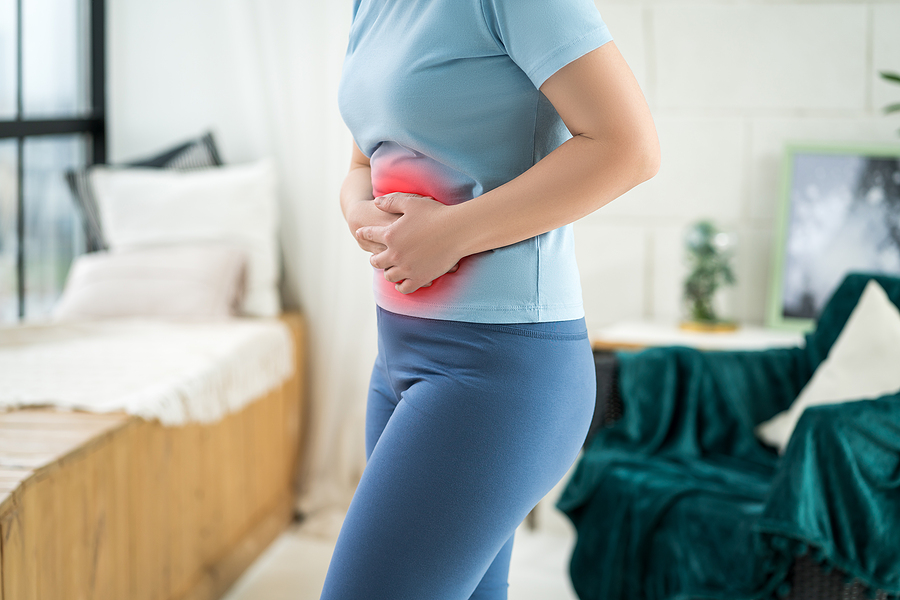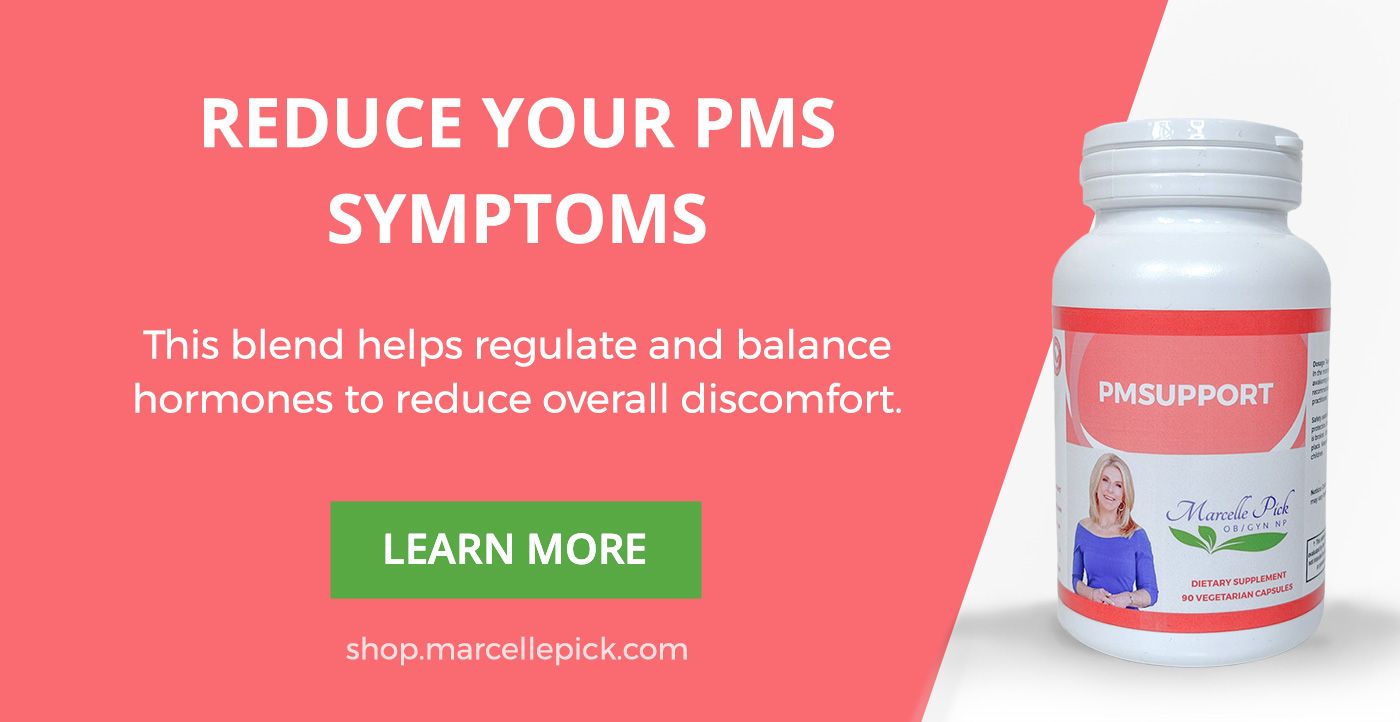Updated 09/17/2023
“This is no way to live!” That’s what Fiona said after describing what the week around her period was like every month. Her anxiety around her PMS was impacting her life all the time; even when she wasn’t experiencing cramps, headaches, irritability, foggy thinking, and general feelings of lethargy and malaise she was on edge just waiting for them to hit again.
Fiona was right. Dealing with severe PMS symptoms isn’t a good way to live – but research indicates that up to half of all women worldwide are impacted! The number varies widely in different parts of the world, with an estimated 20-30% of American women affected by symptoms.
Despite (or maybe because of) how common PMS is, so many women think there’s nothing they can do about it. They’ve been told for years that it’s all part of being a woman, and the best thing they can do is learn to accept it.
I’ve been trying to spread the word that this is not true for decades now, through my practice that focuses solely on women’s health. I learned a long time ago that freedom from PMS is possible – and I’ve been trying to share that news ever since!
All of the women I see for PMS want one thing: for the symptoms to stop. When I educate them about where those symptoms originate, then I can give them concrete strategies to solve the problem. Many are astounded to find out just how much personal control they have; it’s all about making good decisions for their bodies and their health.
Let’s take a look at what PMS is, the most common symptoms women experience, where these symptoms come from, and how to calm them.
What is PMS
Premenstrual Syndrome (PMS) is the name given to recurring monthly symptoms that have an impact on daily life. Almost all of the women I know say they’ve had some symptoms at one time or another related to their menstrual cycle. But for many women these symptoms are more than just occasional annoyances. Every month, like clockwork, they find themselves unable to function normally when the symptoms (both physical and psychological) hit.
Symptoms show up in the second half of the menstrual cycle, and typically subside after menstruation begins. Many women just carry on as usual, pushing through the symptoms to go about their lives. Moderate to severe PMS can make this impossible, however. When the condition is especially severe, it’s known as premenstrual dysphoric disorder (PMDD). PMS and PMDD can have a serious impact on quality of life. That’s why it’s so important to get a handle on what you can do about it!
Common PMS symptoms
There are so many symptoms that have been identified as part of premenstrual syndrome – up to 150! Of course these don’t all happen simultaneously for all women. Every woman’s experience is unique to her. The vast range of symptoms can make sorting PMS out difficult, especially since women don’t always experience the same issues every month.
There are, however, some very common symptoms that occur before menstruation for many women. These include tenderness in the breasts, constipation or diarrhea, bloating, headaches, acne, abdominal cramping, joint pain and/or swelling, and fatigue on the physical side. Psychologically, the most common symptoms are mood swings, irritability, depression and anxiety, weepiness, and becoming easily upset or angry. Common behavioral changes include disrupted sleeping patterns, lack of energy, forgetting things, and having trouble focusing.
None of the symptoms are easy to deal with, and can have a big impact on a woman’s ability to work and take part in activities she usually enjoys. Symptoms, especially those like mood swings and irritability, can also create tension in close relationships. Who wants to go through that every month?
Because there are so many symptoms and each woman’s experience is different, it has been difficult to identify the root cause of premenstrual syndrome. But, as a recent review article shows, hormones certainly have something to do with it!
PMS Symptoms and Hormonal Imbalance
Symptoms of PMS, like symptoms of any health condition, are a cry from your body for help. Because the root causes can’t be seen, they must be felt! But contrary to popular belief, there is a lot you can do to address the issue (not just cover up the symptoms) to make your PMS much milder – or prevent you from developing it at all.
What is happening hormonally during your menstrual cycle? It’s a predictable pattern of rising and falling estrogen and progesterone levels. On the day menstruation begins, levels of both are low. A week or so into the cycle, estrogen begins to rise, peaking just before ovulation, which is day 14 if you have a typical 28-day cycle. After its peak, estrogen drops, rises again between days 21 and 24, then drops once more to begin the whole process all over again. Progesterone levels generally rise between days 14 and 27.
While these fluctuations are natural, and occur for all women, some are more sensitive to the changes. Women with PMS typically don’t show abnormal hormone levels in blood work. But like most health conditions, imbalanced hormones can be a problem before any clinically significant abnormalities show up in testing.
That’s why it’s so crucial for women to understand that they know their own bodies best. If you are feeling things that aren’t typical for you, it’s important to address them early. If you’re experiencing these symptoms, your hormonal health is probably not optimal, regardless of the actual numbers.
Other factors behind PMS
While I believe hormonal changes are the most significant player in PMS, there are plenty of other potential root causes, including nutrient deficiencies, too much stress, overgrowth of yeast (candida), inflammation (including neuroinflammation), hypothyroidism, and excess prolactin.
And there are a number of factors that, while not the cause of PMS, can absolutely increase or exacerbate these painful symptoms. These include depression, stress, smoking, inactivity, poor sleep, and excess consumption of alcohol, sugar, salt or red meat. Chronic health conditions like asthma, allergies or migraines can worsen just before menstruation as well.
Natural Strategies to balance hormones and soothe symptoms of PMS
Yes, hormonal changes are normal and necessary for your body – but that doesn’t mean there’s nothing you can do! The key is to keep hormone health flourishing all the time, not just in the days leading up to menstruation. Following are some tips on how to do so.
Eat to support your hormones
I often feel like a record skipping because I say this so often: food is the best medicine we have. If you do nothing else to change your hormonal health, start eating well and see what a difference it can make. Whole, organic foods are best whenever possible. Fresh produce, protein, fish, healthy fats, whole grains, and fiber are all very important components of a diet designed to keep your hormones functioning well.
If you’ve been existing on fast food or processed, frozen meals, the chemicals won’t clear your system overnight. It took time for your hormones to shift out of balance, and it will take time to get levels back where they belong. Once you do, try to stick to healthy options most of the time. That’s not to say you can’t have an occasional treat – just try to be sure you eat well at least 80% of the time.
Prioritize sleep
Quality sleep is also essential to good hormonal health. Studies have detailed the impact of chronic sleep deprivation. Your body heals itself while you sleep, so hormonal health depends on getting enough! Making a plan (and writing it down) to ensure 7-8 hours of sleep every night can make a big difference. Figure out when you need to be up in the morning and count backwards at least 8 hours. Add a little extra time if falling asleep is difficult for you (so, for example, if you need to be up at 6 am, try to get in bed at 9:30 pm). Try a guided sleep meditation at bedtime to relax and drift off. Read instead of watching TV (but nothing too stressful or anxiety provoking). A cool, dark room sets the stage for quality sleep.
Give yourself a break from constant stress
Chronic stress is so hard on hormonal balance because of the constantly high levels of cortisol being pumped into your system. The world can be incredibly stressful, and if you aren’t giving yourself any time to relax and rejuvenate, your hormonal health will suffer. Avoid watching the news constantly or mindless scrolling on social media, and find activities that make you feel joyful.
Meditation, yoga, gentle stretching and t’ai chi can all help keep you grounded and reduce stress – if you enjoy them! Whatever it is you choose, be sure it isn’t making you more anxious.
Stay active
Moving your body is one of the best ways to level out hormones and relieve PMS symptoms. When you exercise, endorphins are released, which help relieve stress and pain. Exercise can also boost metabolism, curb cravings, and increase circulation which helps with painful symptoms.
It’s important that you don’t overdo it, however. Too much exercise puts a lot of stress on your body, and as I said above, stress can throw hormonal health off balance. Any movement counts, so find something you enjoy – walking, biking, dancing, or playing chase with your children in the yard. If you have a hard time squeezing exercise into your busy day, start by taking the stairs instead of the elevator, walking in place while on a conference call, or parking just a little farther away from the office.
Support your body with supplements or herbs
Eating well is priority one, but even that might not be enough – especially if your hormonal health is already weak. Industrial agriculture depletes the nutrients that food contains, making it difficult to get what you need from eating even if you’re making healthy choices. Talking with an experienced practitioner can help you find the right formula for your unique needs. I always recommend that women include a high-quality multivitamin in their daily routine. Calcium and magnesium, which work cooperatively in your system, as well as Vitamin B6 can often make a difference for symptoms of PMS.
Herbal medicine is another avenue for keeping your body balanced and healthy. Studies have found that chasteberry has a positive impact on irritability, anger, headache and breast fullness as well as other PMS symptoms. Ginkgo Biloba, St. John’s Wort, and black cohosh are other herbs that may be helpful.
I have been helping women understand the connection between PMS symptoms and hormonal health for decades. The suggestions above have produced some results for most women. They certainly did for Fiona! She committed to balancing her hormones naturally, and came back happy to report that she finally didn’t feel like PMS was holding her hostage.
Some women with particularly severe symptoms need even more support, like the kind I provide in my PMS program. I work directly with a leading lab to offer high quality products that make a difference!
When you give your hormonal health the attention it deserves, you can say goodbye to PMS symptoms and live your best life. Suffering is not necessary. When your hormones are healthy, your body is happy – and with relief from PMS, you will be too!









